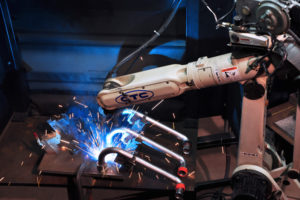Brazing Services
At Woolf Aircraft Products Inc., we put a focus on precision and versatility in developing a variety of high-end welding and brazing services for the aerospace, military, and industrial sectors. These welding services include gas metal, gas tungsten, shielded metal, plasma arc welding, and resistance spot welding. We also provide torch brazing while offering standard and vacuum brazing through an outside, fully certified partner.
For higher volume weldment orders, we offer 2-axis TIG robotic welding machines and 6-axis robotic MIG welding. Automation such as these services increases our efficiency and turnaround speeds, while our in-house fixturing allows us to perform highly uniform precision welds with low tolerances and high uniformity.
We’re proud to offer our specialized welding services, including both wire fed orbital welding and autogenous orbital welding. These specialty services guarantee tube ends prepared improperly do not result in premature failure of the weld, and that we deliver high-quality tube weldments.
Our use of purge chambers to weld titanium tubing and assemblies ensures that inert gas covers the surface entirely preventing any atmospheric contamination from damaging the weld’s integrity. Throughout the welding process, oxygen sensors ensure the welding surface remains properly shielded.
Either in-house or by third-party certified weld inspectors, various non-destructive tests and inspection can be performed according to applicable industry standards. If necessary, hydrostatic testing up to 10,000 pounds is also available.
Brazing 101
A metal-joining process, brazing involves melting a filler metal to over its melting point of 450°C, but below the melting point of the workpiece. More specifically, brazing is a method of joining the workpieces into a weldment by filling the space between them with a molten filler metal. This process looks similar to soldering but calls for higher temperatures and produces a much stronger junction. The molten filler metal enters the junction through capillary action, then cools to form a tighter and stronger bond between the workpieces over soldering.
The brazing process occurs without ever melting or damaging the workpieces, though it typically requires a flux or purge chamber to keep atmospheric conditions from interfering with the process. In the purge chamber, the brazing can take place within a flux, or inert gas, rather than exposing reactive elements like oxygen to the hot metals. This exposure would potentially reduce the strength of the joint. To its advantage, brazing forms bonds of significant strength between different metals and metals with high melting points.
Brazing Process
Torch Brazing
As the name implies, torch brazing uses a hot gas torch to melt the filler metal near or on the joint. Choosing a filler metal with a melting point below the oxidation point of the workpiece makes the joint stronger. Great for highly sophisticated, specialized production, this common method of brazing also allows for differing levels of automation and manual control, creating a balance between human skill and production speed and uniformity. Generally, more specialized requirements call for a skilled craftsman’s eye while simpler, larger-scale orders can be mostly or entirely automated.
There are three types of torch brazing: manual, machine, and automatic. With the manual method, an expert welder uses a fixed or handheld torch. As the most labor-intensive of the three methods, it works best for complicated, hard-to-reach joints and small batches. The machine method mixes the benefits of manual and automatic methods. An operator controls the jigging of the joint’s parts as well as the orientation of the braze materials. Then with consistency and speed, an automated machine handles the torch. Lastly, the automatic method works most effectively for simpler high-volume runs. Despite its decreased versatility over the more manual methods, it has the added benefits of very high uniformity and a more efficient production rate.
Furnace Brazing
Furnace brazing works very similarly to torch brazing, but instead of utilizing a hot gas torch to liquefy the filler metal, the entire assembly is placed inside a furnace to reach the proper temperature. Also performing this process within a purge chamber prevents the workpieces and joints from oxidizing. This protective atmosphere features oxygen sensors to alert expert technicians and welders to any possible contaminants within the chamber.
Both fairly cost-effective methods of brazing, torch, and furnace brazing enable the creation of high-strength joints through easily repeatable processes.
Materials We Work With
The brazing process can be conducted on various materials, such as:
- Steel
- Stainless Steel
- Aluminum
- Inconel
- Titanium
- Brass
- Copper
- Copper-Nickel
- Alloy 40 (21Cr-6Ni-9Mn Stainless Steel)
- Hastelloy
Additional Services
At Woolf Aircraft Products Inc., we strive to meet customer demands by offering many additional services:
- Boring
- Brazing
- Welding
- Forming
- Machining
- Milling
- Shearing
- Grinding
- Mechanical Assembly
- Part Marking
- T-Drill Pullout
- CNC Machining
Contact Woolf Aircraft for Brazing Services
Wolf Aircraft, Inc. comes equipped to handle the fabrication of tubing from 0.0625″ to 8″ in lot sizes of 1 to 40,000. Coupled with our wide repertoire of welding, brazing, fabricating, and tube bending capabilities, we offer the flexibility to deliver exactly to customer specifications.
Our welding certifications include AWS D17.1, AWS D1.6, and AWS D1.1, and our quality management system is ISO 9001:2015C and AS9100C certified. Additionally, we are compliant with all applicable industry standards such as Mil-Spec, AMS, ASTM, and ASME. Located centrally for easy transportation just a few miles from Detroit Metropolitan Airport and major trucking terminals, we ensure easy access to our products and faster delivery times.






